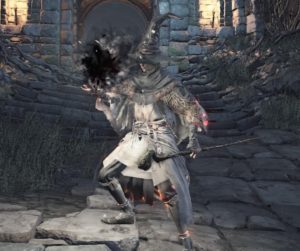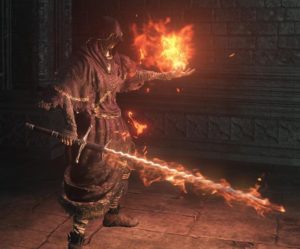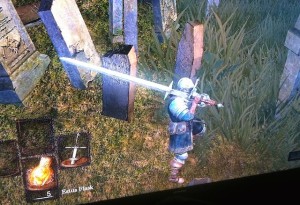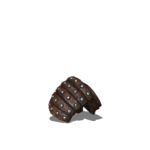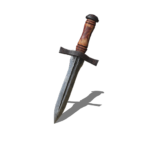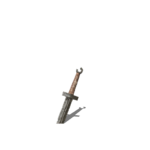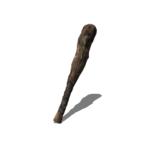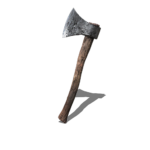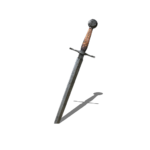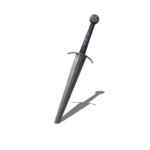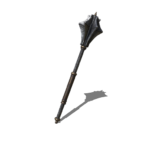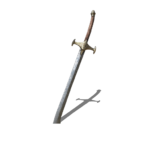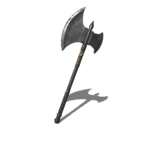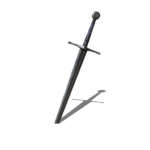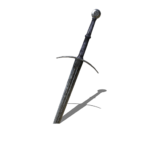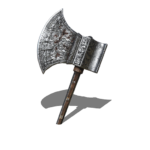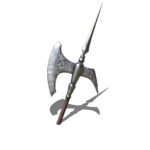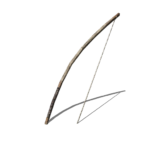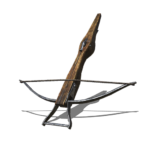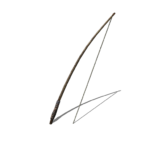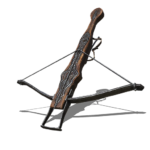Adventurer playbook determines starting ability scores, starting HP pool, starting gear, and starting spells (when appropriate).
Initially, I am developing four playbooks based on Dark Souls classes and one custom playbook. The four playbooks inspired by Dark Souls are Bandit, Deprived, Knight, and Pyromancer. The custom playbook is the Summoner and is based heavily on the OD&D summoner I posted before.
| Playbook |
HP Pool |
Str |
Dex |
Con |
Int |
Wis |
Cha |
| Bandit |
1d10 |
16 |
12 |
12 |
9 |
9 |
9 |
| Deprived |
1d4 |
9 |
9 |
9 |
9 |
9 |
9 |
| Knight |
1d12 |
14 |
10 |
14 |
9 |
10 |
11 |
| Pyromancer |
1d6 |
10 |
10 |
10 |
12 |
10 |
9 |
| Summoner |
1d6 |
9 |
12 |
10 |
13 |
10 |
12 |
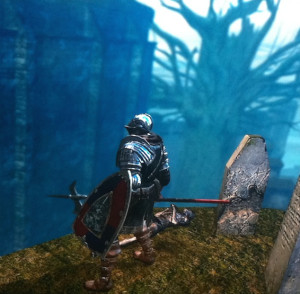
My first Dark Souls dude, with a shield
Similar to Dark Souls, all adventurers sharing a playbook start with identical ability scores, as shown above. Players differentiate adventurers primarily through advancement choices during play though there are also a few choices per playbook regarding starting gear.
I chose these 5 playbooks because they include a damage-oriented melee class (the Bandit), a defense-oriented melee class (the Knight), a damage-oriented ranged class (the Pyromancer), and a hard-mode class (the Deprived). The Summoner provides a magic-using class that relies on minions.
The full list of potential playbooks includes Bandit, Cleric, Deprived, Hunter, Knight, Pyromancer, Sorcerer, Summoner, Thief, and Warrior. The playbooks of next-highest priority to me are the Hunter (for a non-magical ranged class) and the Sorcerer (for a more general magic-user).
Most adventurer capabilities are determined by ability scores, which also have approximately the same bonuses (and meanings) as in traditional B/X. Ability scores are also used for traditional roll-under (<=) ability checks. Disadvantage, as in fifth edition, means to roll two dice and take the least favorable result.
Weapons
Strength and dexterity determine which melee and missile weapons (respectively) an adventurer my use without penalty, categorized by damage die, as shown in the table below. For example, an adventurer with strength at least 10 may use melee weapons that deal 1d4 or 1d6 damage. Adventurers may use weapons with greater die sizes, but make attack rolls with disadvantage when doing so and do not add ability bonuses.
| Score |
Die |
| 8 |
1d4 |
| 10 |
1d6 |
| 12 |
1d8 |
| 14 |
1d10 |
| 16 |
1d12 |
Armor
Constitution, in addition to adding HP to the HP Pool and functioning as an endurance or fortitude saving throw, limits the adventurer’s max AC. For example, an adventurer with constitution of 14 may wear armor that grants up to AC 14. Adventurers wearing armor granting AC higher than the constitution score make all physical tests (ability checks and attack rolls) with disadvantage. Unarmored AC is 10 (including for the Deprived, even though the Deprived begins with constitution of 9).
Attack Bonus
Edit: the weapon upgrade rules replace the attack bonus.
Adventurers have an attack bonus (determined by level). Add the attack bonus to attack rolls made when using a weapon that does not exceed ability score damage die limits. For example, an adventurer with strength 10 that attacks with a 1d10 weapon does not add the attack bonus (and in fact makes the attack roll with disadvantage, as described above). The attack bonus is calculated as level divided by two, rounded up, plus one (or consult the following table).
| Level |
Attack Bonus |
| 1 |
+2 |
| 3 |
+3 |
| 5 |
+4 |
| 7 |
+5 |
| 9 |
+6 |
HP Pool
Potential adventurer HP is recorded as a dice expression plus the constitution bonus. At first level, this will include one die (and possibly a bonus, depending on playbook). For example, the knight begins with an HP Pool of 1d12 + 1. An example of a higher-level HP pool is:
1d12 + 1d6 + 1d6 + 1
Adventurers recover by re-rolling their HP Pool when resting in safety.
Carrying Capacity
Adventurers may equip several location-specific items (head, torso, left hand, right hand) and have an additional set of item slots equal to the strength score. Some items may be bundled, such as throwing knives. Such items require only a single item slot up to the bundle limit. Bundle limits are determined by specific items. For example, the bundle limit of throwing knives is 6.
Magic
Intelligence determines number of spells an adventurer can know (intelligence – 10, min 0). For example, an adventurer with intelligence 13 can know up to 3 spells. After casting a spell, an adventurer must make an intelligence check. If the adventurer fails this check, that spell may not be used again until the adventurer rests in safety. This makes the number of spell uses uncertain, but never less than 1.
Minions
Charisma determines number of minions an adventurer can control (charisma – 10, min 0). For example, an adventurer with charisma 12 can control up to 2 minions. Commanding minions requires charisma checks in some circumstances. The charisma bonus applies to minion attack and damage rolls.
Advancement
To gain a level, spend coins equal to level multiplied by 1000. For example, to advance from second to third level, spend 2000 coins worth of treasure. Merchants are only interested in coins, gems, and precious artifacts. The focus of these rules is not on scavenging curtains and furniture from dungeons (not that there is anything wrong with that). Adventurers may advance in level wherever they can spend treasure, including deep within a dungeon, assuming the can find a merchant to deal with.
When gaining a level, adventurers add 1d6 to the HP Pool, choose one ability score to increase by one point, and increase the attack bonus (for odd levels). The maximum adventurer level is 10. Ability scores may not be raised above 18.
For moderate niche protection, I set playbook starting ability scores so that non-magical classes must dedicate one level of advancement to increasing intelligence before they can start learning spells. That is, advancing intelligence from 9 to 10 requires a level but does not grant any spell slots (since 10 – 10 = 0). The adventurer must then spend another level (increasing intelligence to 11) to gain the first spell slot. Advancing from 9 to 10 is not totally without mechanical benefit, even though it does not grant a spell slot, since saving throws versus magic use intelligence checks.
Ability Bonuses
The strength bonus adds to melee attacks and damage. The dexterity bonus adds to missile attacks and damage (but not AC). The constitution bonus adds to the HP Pool. The wisdom bonus adds to miracle effects (to be discussed in a future post). The intelligence bonus adds to spell effects (such as damage). The charisma bonus adds to minion attack and damage rolls. All other resolution systems use simple ability checks. For example, reaction rolls are handled as charisma checks. Ability score bonuses follow the traditional B/X schedule of tiers made up of 13-15, 16-17, and 18.
| Score |
Bonus |
| 13 |
+1 |
| 16 |
+2 |
| 18 |
+3 |

